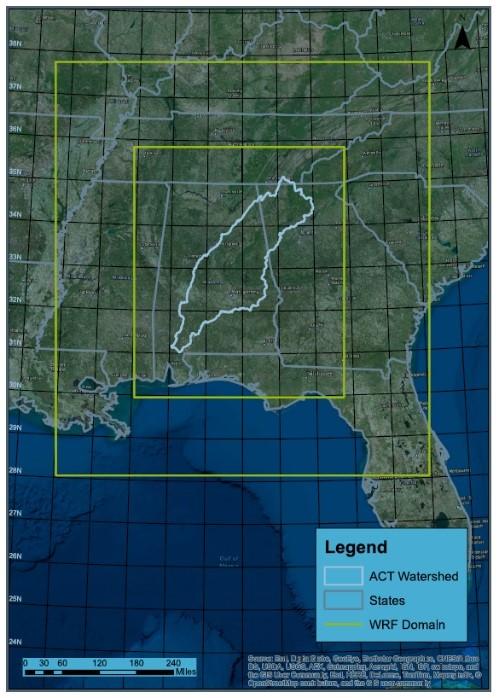
A numerical weather forecasting model (WRF) was used to simulate 120 storms over the Alabama-Coosa-Tallapoosa (ACT) river basin to explore the effect of climate change on probable maximum precipitation (PMP).
PMP is defined as the largest rainfall depth that could physically occur under a series of adverse atmospheric conditions. It is the design standard of highly important energy-water infrastructures such as dams and nuclear power plants. To understand how PMP may respond to projected future climate forcings, a physics-based numerical weather simulation model was used to estimate PMP across various durations and areas.
Results show that the simulated PMP is projected to increase under future climate conditions. Taking 1981–2010 values as the baseline, the simulated PMP is projected to increase around +20% during 2021–2050 and +44% during 2071–2100. The additional sensitivity simulations of background air temperature warming also showed an enhancement of PMP, suggesting that atmospheric warming could be one important factor controlling the increase in PMP.
The study also emphasizes the need to further strengthen the understanding of PMP for engineering applications. Various types of uncertainty – from driving forcings, the ability of numerical models to simulate rainfall depth, and approaches to achieving PMP rainfall, to the selection of extreme storms – all need to be better understood before a simulated PMP can be fully developed for application.
The results of this study are described in an article in the Journal of Geophysical Research: Atmospheres. The work was a collaboration with the Climate Change Science Institute, the Computer Science and Mathematics Division, the Environmental Sciences Division, the Nuclear Security and Isotope Technology Division and the Computational Sciences and Engineering Division at Oak Ridge National Laboratory. Researchers from The Bredesen Center at the University of Tennessee, the Institute of Bio- and Geosciences Agrosphere (IBG-3), the Research Centre Jülich in Jülich Germany, and the RAND Corporation also participated in this research
Rastogi, D., Kao, S-C., Ashfaq, M., Mei, R., Kabela, E.D., Gangrade, S., Naz, B.S., Preston, B.L., Singh, N., Anantharaj, V.G., “Effects of climate change on probable maximum precipitation: A sensitivity study over the Alabama-Coosa-Tallapoosa River Basin”, Journal of Geophysical Research: Atmospheres, 2017. doi:10.1002/2016JD026001
Funding for this research was provided by The U.S. Department of Energy, Office of Science, Biological and Environmental Research, the Integrated Assessment Program, and the ORNL Laboratory Directed Research and Development Program. The research used resources of the Oak Ridge Leadership Computing Facility at ORNL.







